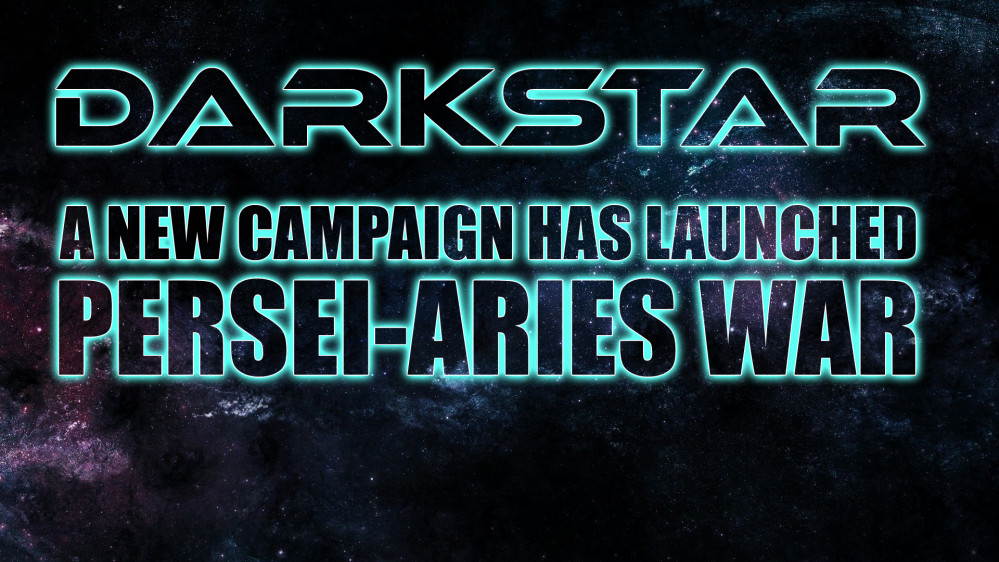
Persei-Aries War Resumes
Massive 500-Point Battle, Star System Almost Lost, Faction Hangs by a Thread
FROM: UNITED NATIONS REGIONAL COLONIAL CENTER
21:45 SOL GMT, 14 MARCH 2521
BREAKAUTH: 181072.18J
CLEARANCE: SECRET (NATIONAL)
**UNITED NATIONS COMMUNIQUE**
A major shift seems to be in the making in the ongoing Third Hercules War. Reports continue to come in from the far-flung systems of the Hercules Rim, and the full impact of recent events presently remains unclear. However, observers agree that the United States had undertaken a significant shift in strategy, and made a much more aggressive move in the conflict.
Until recently, the “Coalition of Eagles” (United States, Holy Russian Empire, and supporting factions) have pursued a “siege” approach to the Third Hercules War. With Russian colonies along the coreward shoulder of the Hercules Rim at Kransaya Nadhezda (“Red Hope” at 72 Hercules), and American and Indian Republic colonies along the spinward edge at Vega and Bhogavati (Alpha Lyra and HD 176051), the idea was to squeeze the British and Japanese in their more central colonies until their governments ceded at the peace table.
When the American and Indian Navies more or less smashed the “Black Dragons” (Khitan-Tunguska Free State) out of the war and forced them to abandon their colonies at Khaizan’s Haven (14 Hercules), the moment seemed perfect to expand on this strategy. Seizing this abandoned system would all but surround the British and Japanese with American, Indian, and Russian holdings. However, the Holy Russian Empire suffered a sharp defeat at 14 Hercules when the Arab League abruptly entered the war and signed an alliance with the Renkei Alliance (United Kingdom, Japan).
Acknowledging at last that this “siege strategy” will not work, the Americans have now embarked on a much more direct approach. The newly-arrived “Task Force Liberty” carrier-cruiser group, under the command of Captains Zachary Irons and David Cheatham, is sent directly into the British colonies at Hawking’s Star (HR 6806). To support this effort, a Russian Slava-class heavy cruiser, CPK Rotislav, attacks from the other direction, vectoring in from Krasnaya Nadhezda. The attack takes quite a while to put together (some of these ships have to cover upwards of 18 light-years), and doesn’t actually commence until the middle of March, 2521. Even at this late date, the strike is in fact somewhat rushed. Originally planned as an assault (supported by two Saipan-class USMC planetary assault ships), the time scales were projected out into the beginning of May, by which time any chance at surprise would sure be lost. Instead this operation is to be conducted as a strike, directly it the heart of the Hawking’s Star colony.
As the Americans and Russians converge on the HR6806 system and emerge from their 10th magnitude Darkstar waves (easily detectable well in advance, especially with ships this large), the British mobilize a powerful defense force. The entirety of Cruiser Squadron “A” (Agamemnon) is mobilized against the threat. Of particular note will be the elite aerospace strike group of the large Valiant-class light fleet carrier HMS Vindictive pitted against the elite (some would say nigh-legendary) aerospace squadrons of the Endeavor-class USS Liberty, including Fighter Squadron VSF-221 (“The Dead Rabbits”) and Attack Squadron VSA-193 (“The Eight Ball Express”).
US/Russians: @Oriskany
UK: @Damon
497-point raid
Carrier-Cruiser Raid into Heart of Enemy Star System – Hawking’s Star (HR6806) – March 14, 2521
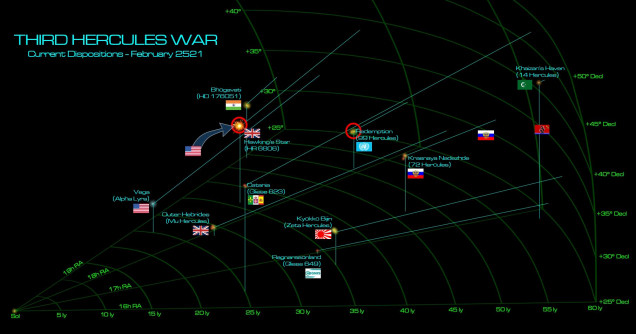 Here is the current state of the Hercules Rim warzone. With their hopes dashed for an allied foothold at 14 Hercules (Khaizan’s Haven which could’ve been a possible staging point “behind” the British and Japanese), the Americans resolve to kick down the front door with a direct strike into HR6806 (Hawking’s Star).
Here is the current state of the Hercules Rim warzone. With their hopes dashed for an allied foothold at 14 Hercules (Khaizan’s Haven which could’ve been a possible staging point “behind” the British and Japanese), the Americans resolve to kick down the front door with a direct strike into HR6806 (Hawking’s Star).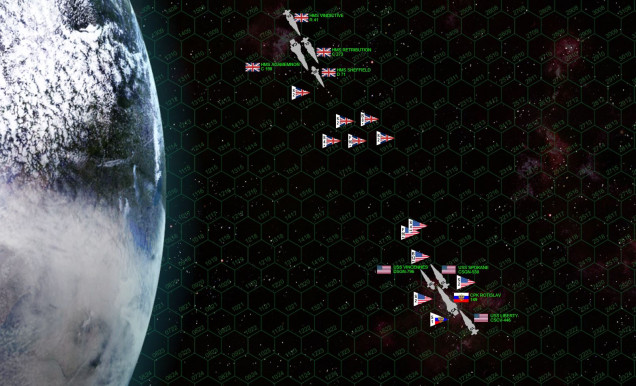 Here is the matchup. Note that most of these aerospace groups are either elite (one “*”) or double-elite (two “*”). The cruisers will be trading heavy gunfire to be sure, but there will also be a very nasty dogfight as over 70 fighters, bombers, and scouts mix it up or launch devastating aerospace strikes on the capital ships. Speaking of the warships, Cruiser Squadron “A” has become a truly formidable force. Over almost a year of play Damon has worked this task force up to nearly 500 points including all his upgrades, in fact he can’t upgrade any more or he’ll be over 500 points, beyond the command limit of Lord Edward Cavendish. He’ll have to pick up a few promotions and command ratings before he’s allowed to command a 500+ point FLEET instead of a 251-500 point Task Force. In summary, he needs a spot in the Admiralty, at least a Commodore’s star on his shoulder.
Here is the matchup. Note that most of these aerospace groups are either elite (one “*”) or double-elite (two “*”). The cruisers will be trading heavy gunfire to be sure, but there will also be a very nasty dogfight as over 70 fighters, bombers, and scouts mix it up or launch devastating aerospace strikes on the capital ships. Speaking of the warships, Cruiser Squadron “A” has become a truly formidable force. Over almost a year of play Damon has worked this task force up to nearly 500 points including all his upgrades, in fact he can’t upgrade any more or he’ll be over 500 points, beyond the command limit of Lord Edward Cavendish. He’ll have to pick up a few promotions and command ratings before he’s allowed to command a 500+ point FLEET instead of a 251-500 point Task Force. In summary, he needs a spot in the Admiralty, at least a Commodore’s star on his shoulder.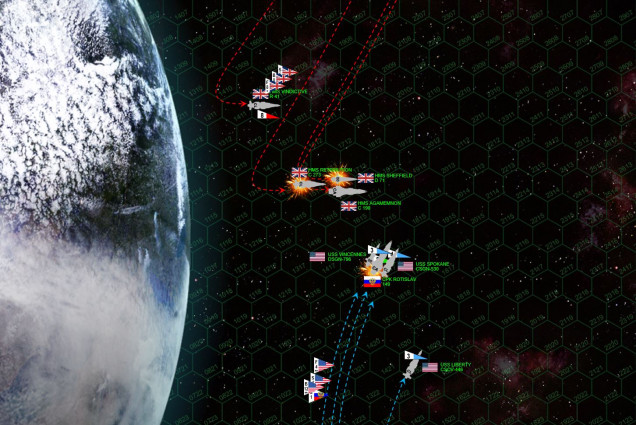 The battle begins. The Americans and Russians set a very fast approach speed, closing the distance very quickly against the British. Once the Agamemnon loses initiative, the heavy Rotislav lines up a perfect broadside against her. Note that the Rotislav will have a broadside on the Agamemnon but the Agamemnon will only have forward guns in return. Sleek, hyper-advanced, and heavily-upgraded (not to mention extremely expensive) American USS Spokane (San Antonio class light cruiser) streaks in as well, along with the destroyer USS Vincennes (Valcour class, same as USS Oriskany only not nearly as well-upgraded). Once the HMS Sheffield and HMS Retribution pull in alongside and astern of Agamemnon, the American and Russian guns switch to them. Clearly they want an early lead in this battle, so decide to clip a few of the smaller ships first. Even as the British and American carriers hang back and begin launching their elite fighter groups, the Russian and especially American buns positively maul the Sheffield, burning through her forward magazine and bridge ... while the light cruiser Retribution is all but blown in half. British fire mauls the Rotislav ... but this is possibly a mistake. While certainly the biggest ship on the table (heavy cruiser, 168,000 tons), she’s but no means the most dangerous (she’s worth only 101 points, the much lighter USS Spokane is 163). The USS Spokane, Liberty, and even Vincennes are probably the bigger threat, and thus get his first deadly round of fire “free.” It cost the British the HMS Sheffield and Retribution, while the CPK Rotislav’s port bow is gutted, forward magazine hit, and bridge damaged ... but remains operational at least for now.
The battle begins. The Americans and Russians set a very fast approach speed, closing the distance very quickly against the British. Once the Agamemnon loses initiative, the heavy Rotislav lines up a perfect broadside against her. Note that the Rotislav will have a broadside on the Agamemnon but the Agamemnon will only have forward guns in return. Sleek, hyper-advanced, and heavily-upgraded (not to mention extremely expensive) American USS Spokane (San Antonio class light cruiser) streaks in as well, along with the destroyer USS Vincennes (Valcour class, same as USS Oriskany only not nearly as well-upgraded). Once the HMS Sheffield and HMS Retribution pull in alongside and astern of Agamemnon, the American and Russian guns switch to them. Clearly they want an early lead in this battle, so decide to clip a few of the smaller ships first. Even as the British and American carriers hang back and begin launching their elite fighter groups, the Russian and especially American buns positively maul the Sheffield, burning through her forward magazine and bridge ... while the light cruiser Retribution is all but blown in half. British fire mauls the Rotislav ... but this is possibly a mistake. While certainly the biggest ship on the table (heavy cruiser, 168,000 tons), she’s but no means the most dangerous (she’s worth only 101 points, the much lighter USS Spokane is 163). The USS Spokane, Liberty, and even Vincennes are probably the bigger threat, and thus get his first deadly round of fire “free.” It cost the British the HMS Sheffield and Retribution, while the CPK Rotislav’s port bow is gutted, forward magazine hit, and bridge damaged ... but remains operational at least for now.  Still moving very fast (neither the British or the Americans are wasting any time on this one), the two fleets race past each other, many ships standing on their retros and gravity rudders, screaming to slow down and turn as best they can. One exception is the Rotislav, which is already breaking for the far edge of the table. Even heavily damaged, if she can remain operational she’ll remain a potent threat this deep in an enemy star system (RAID victory rules in this game). Surviving British and American ships also struggle to remain close together ... because by now both HMS Vindictive and USS Liberty have completed their aerospace launches, and both sides are ready to unleash a withering barrage of aerospace missiles and torpedoes. The bombers of USN Attack Squadron VSA-193 (“The Eight Ball Express”) put a hail of ASM-56 Harpoon torpedoes into the stern of the Agamemnon, while the fighters of USN VSF-221 (“The Dead Rabbits”) do the same with their ASM-92 Hellfires. Many are shot down, along with Mark 48 torpedoes from the USS Liberty, Vincennes, and Spokane. But enough hits are scored in this massive strike that the Agamemnon is crippled. This explains the strategy the Americans turn the previous turn, knocking down a few smaller British ships, even though they were smaller, greatly weakened the overall British mass driver point defense strength in anticipation of this combined aerospace – torpedo strike.
Still moving very fast (neither the British or the Americans are wasting any time on this one), the two fleets race past each other, many ships standing on their retros and gravity rudders, screaming to slow down and turn as best they can. One exception is the Rotislav, which is already breaking for the far edge of the table. Even heavily damaged, if she can remain operational she’ll remain a potent threat this deep in an enemy star system (RAID victory rules in this game). Surviving British and American ships also struggle to remain close together ... because by now both HMS Vindictive and USS Liberty have completed their aerospace launches, and both sides are ready to unleash a withering barrage of aerospace missiles and torpedoes. The bombers of USN Attack Squadron VSA-193 (“The Eight Ball Express”) put a hail of ASM-56 Harpoon torpedoes into the stern of the Agamemnon, while the fighters of USN VSF-221 (“The Dead Rabbits”) do the same with their ASM-92 Hellfires. Many are shot down, along with Mark 48 torpedoes from the USS Liberty, Vincennes, and Spokane. But enough hits are scored in this massive strike that the Agamemnon is crippled. This explains the strategy the Americans turn the previous turn, knocking down a few smaller British ships, even though they were smaller, greatly weakened the overall British mass driver point defense strength in anticipation of this combined aerospace – torpedo strike.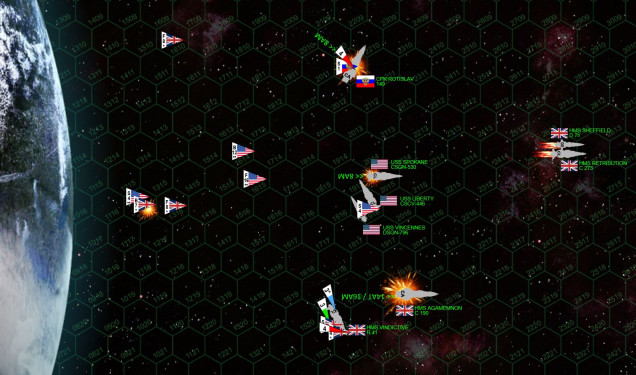 The British meanwhile, also have a significant aerospace wave of their own. Three factors, however, prove decisive. One, the Americans have lost no ships. Although the Rotislav is too far away to help with point defense, the Liberty has electronic warfare upgrades and together with the Spokane and the Vincennes is able to put up a much better defense. Two, the British force doesn’t have quite the same number of capital ship gravitic torpedoes, allowing the Americans to focus against the British fighter/bomber strike. Three, the British divide their strike between the USS Spokane and the CPK Rotislav. While this is almost always a bad move, in this case it might’ve paid off because the Rotislav has completely lost its port bow shields. One missile or torpedo in the bridge would knock out the ship and net the British 100 points. Almost all the missiles hit, but hit LOCATION is just plain bad luck for the British. Almost all the missiles just hit too far forward, they blow a virtual tunnel through the Rotislav’s fo’c’sle and two missiles literally pass THROUGH the gaming hole and never explode. Unbelievably, the Rotislav escapes under her own power, denying the British victory points. Meanwhile, the weakened missile strike against the Spokane is largely fended off. The one bright spot for the British is the gunnery against the stern of the USS Vincennes, enough to cripple her and leave her burning and adrift in space.
The British meanwhile, also have a significant aerospace wave of their own. Three factors, however, prove decisive. One, the Americans have lost no ships. Although the Rotislav is too far away to help with point defense, the Liberty has electronic warfare upgrades and together with the Spokane and the Vincennes is able to put up a much better defense. Two, the British force doesn’t have quite the same number of capital ship gravitic torpedoes, allowing the Americans to focus against the British fighter/bomber strike. Three, the British divide their strike between the USS Spokane and the CPK Rotislav. While this is almost always a bad move, in this case it might’ve paid off because the Rotislav has completely lost its port bow shields. One missile or torpedo in the bridge would knock out the ship and net the British 100 points. Almost all the missiles hit, but hit LOCATION is just plain bad luck for the British. Almost all the missiles just hit too far forward, they blow a virtual tunnel through the Rotislav’s fo’c’sle and two missiles literally pass THROUGH the gaming hole and never explode. Unbelievably, the Rotislav escapes under her own power, denying the British victory points. Meanwhile, the weakened missile strike against the Spokane is largely fended off. The one bright spot for the British is the gunnery against the stern of the USS Vincennes, enough to cripple her and leave her burning and adrift in space. 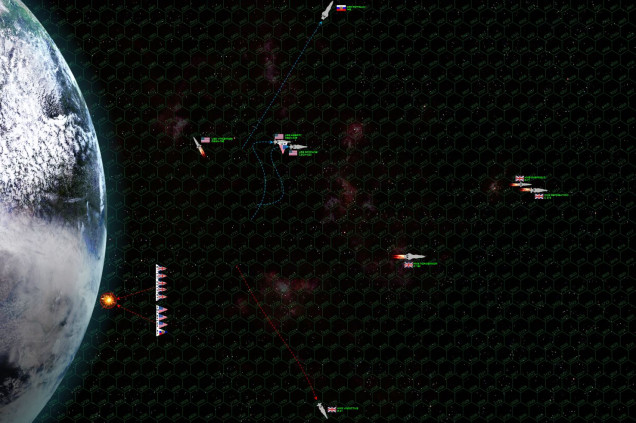 Now alone, the British carrier HMS Vindictive beats a hasty break-off, denying the Americans at least victory points for crippling, destroying or even capturing her. The fighters and bombers engage with the Americans near the planet in a huge dogfight, helping cover Vindictive’s withdrawal. The move costs the British all their bombers, but American fighters suffer heavily (engaged against British bombers while British Starfires engaged the American Corsair fighters). Meanwhile, the American Avenger bombers have all landed back aboard USS Liberty, re-arming for a second strike that will never be necessary.
Now alone, the British carrier HMS Vindictive beats a hasty break-off, denying the Americans at least victory points for crippling, destroying or even capturing her. The fighters and bombers engage with the Americans near the planet in a huge dogfight, helping cover Vindictive’s withdrawal. The move costs the British all their bombers, but American fighters suffer heavily (engaged against British bombers while British Starfires engaged the American Corsair fighters). Meanwhile, the American Avenger bombers have all landed back aboard USS Liberty, re-arming for a second strike that will never be necessary. 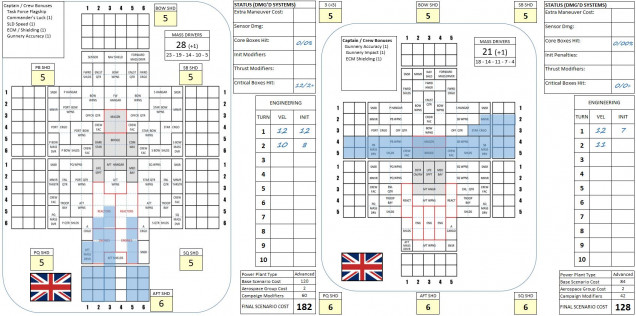 This battle was mercifully short, never formally lasting into Turn 04. The Americans have won by +321 out of a 497 point battle, a 65% margin that clearly indicates a DECISIVE victory. Honestly, I have a lot of experience with the particular ships and these particular upgrades, I feel Damon might have misidentified the Rotislav as the greater threat vs. USS Spokane (again, 101 points vs. 163 points), and the British were just dogged by plan bad luck (by all rights the Rotislav should have been crippled TWICE – as it was she wasn’t even driven off).I would say the divided aerospace strike was a “mistake” – except it wasn’t, it was an honest gamble that should have worked ... it just didn’t due to spectacularly bad hit LOCATIONS on the Rotislav. By contrast, here are the Warship Record Sheets for HMS Agamemnon and HMS Retribution. Not all the American guns hit, but those that did, hit right where they should have. The cripple results on these British warships are almost COMICALLY surgical. This is just Lady Luck, nothing more.
This battle was mercifully short, never formally lasting into Turn 04. The Americans have won by +321 out of a 497 point battle, a 65% margin that clearly indicates a DECISIVE victory. Honestly, I have a lot of experience with the particular ships and these particular upgrades, I feel Damon might have misidentified the Rotislav as the greater threat vs. USS Spokane (again, 101 points vs. 163 points), and the British were just dogged by plan bad luck (by all rights the Rotislav should have been crippled TWICE – as it was she wasn’t even driven off).I would say the divided aerospace strike was a “mistake” – except it wasn’t, it was an honest gamble that should have worked ... it just didn’t due to spectacularly bad hit LOCATIONS on the Rotislav. By contrast, here are the Warship Record Sheets for HMS Agamemnon and HMS Retribution. Not all the American guns hit, but those that did, hit right where they should have. The cripple results on these British warships are almost COMICALLY surgical. This is just Lady Luck, nothing more.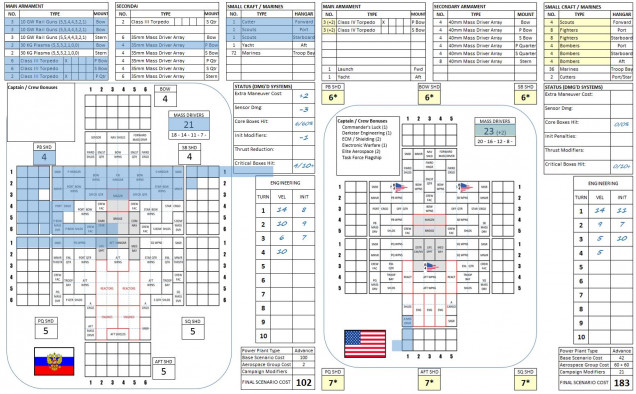 Here are the WRS for the hapless CPK Rotislav and USS Liberty. You can see the amount of punishment the British put into this Russian heavy cruiser, but like a stubborn Russian mule she just wouldn’t go down. The Liberty, meanwhile, is practically unscathed ... we can see the bombers where they were landed in her bays, rearming for a potential second strike.
Here are the WRS for the hapless CPK Rotislav and USS Liberty. You can see the amount of punishment the British put into this Russian heavy cruiser, but like a stubborn Russian mule she just wouldn’t go down. The Liberty, meanwhile, is practically unscathed ... we can see the bombers where they were landed in her bays, rearming for a potential second strike.So what does this shattering result mean? Well, a major defeat in a 400+ point battle means +/-6 campaign points for the factions involved. The Americans win +4, the Russians +2, and the British lose -6. The British campaign tracker now has them at -10, the absolute limit of their government’s commitment to this war. Suffice it to say that debate rages in the Parliament over whether to sue for peace, and the Prime Minister has been subjected to a Vote of No Confidence, which for the moment he has survived … barely.
Along the Hercules Rim, and specifically at Hawking’s Star … while a MAJOR victory of this scale normally gives the star system to the winner outright, please remember that this game was played as RAID, not an ASSAULT. In campaign rules, the attacker has to declare they’re launching an assault – where victory points are calculated differently and thus tabletop strategy is decidedly different – THEN win a battle of sufficient size (although it doesn’t necessarily have to be a MAJOR victory). This represents operational and logistic planning and support for an actual colonial invasion, like the two Saipan class planetary assault ships mentioned previously (these are basically Endeavor class light fleet carriers, outfitted to carry assault boats, troops, and grav tanks instead of fighters and bombers). So while the Royal Navy has been decisively crippled at Hawking’s Star, the Americans just don’t have the Marines, engineers, and logistic support to mount an immediate invasion, at least not closer than 12 light-years.
So we’re settling on a compromise. The Americans now have a FOOTHOLD in the Hawking Star (HR6806 system), not at the terrestrial planet itself, but among the moons of the outer gas giants. In narrative terms, we could have the Marine assault ship USS Tarawa (part of Task Force Oriskany, upgraded with 12-mag Darkstar Waves) get to HR6806 in less than five days, and put a company or two down on these perimeter outposts. But a destroyer-sized carrier / assault ship like the Tarawa could never boot enough boots on the ground to take Hawking’s Star colony itself, at least not all in one go.
That said, the Americans are dominating in the Third Hercules War, and the British are clinging to survival by the slenderest of threads. After victories in the Psi Serpentis War, the Second Hercules War, and most recently in Duchess Annabel’s War, are they finally about to lose one? One more decent American or Russian victory in the Hawking’s Star colonies will lose the system for the Crown, and force the British to sue for peace.








































































Definitely some hard lessons learned with this game.
Time for some hasty repairs and a few ‘robust exchanges’ between the Admiralty and battlegroup command staff.
You were a really great sport on this one, @damon – writing it up afterwards and looking at the WRS sheets, it really looks like at least 50% of this outcome is due to the hit location. If the Rotislav had gone down in the first exchange, the Americans are still winning NARROWLY at that point, but then that big aerospace strike isn’t divided in Turn 2. And again, in both big fire phases, the weapons are hitting the ship, just not in the right places. Another more “operational-level” issue is having just one faction involved on the Renkei side.… Read more »
Been busy at work the last few days. Only just got to read this. Really nice high stakes clash between the big guns.
Having just entered the war I think the Arab league will want to try and cautiously persuade the British to continue low scale skirmishes until we can rectify this upset. This could be some thing the Arab league, with its high end Darkstar drives might be able to help out with.
Cautiously though… we aren’t up there in the big leagues yet…
Good games all!
@muakhah – I would say the British should “share battles” for a while so the impact of any losses is spread across multiple factions – but they’re actually past that. They’re at -10 out of 10 … literally one more single point of campaign loss and they’re out. Then again, they’ve won three of the four major wars they’ve been in up until now (Psi Serpentis, Hercules Gate, Duchess Annabel’s War … they admittedly lost the Andromeda Arc War). I would say they have to go all-in now, one “Hail Mary” battle against the Russians or Corporate Consortium. The risk… Read more »
Turn my back for a moment … I guess the IJN have to come to the rescue
It’s been a while since there was a really good US / Japan Pacific War reenactment … 😀
@oriskany we will have to find a day once all this holiday fun is over
😀 Sounds good